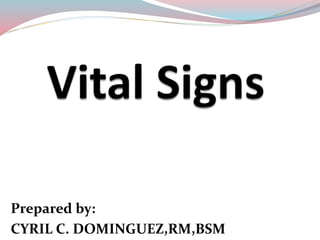
2.-Vital-Signs.pptx
- 1. Prepared by: CYRIL C. DOMINGUEZ,RM,BSM
- 2. A.TEMPERATURE - balance between the heat produce & heat loss in the body. 2 Types: 1.Surface Temperature-temp. on skin, subcutaneous & fats 2.Core Temperature-deep tissue temperature
- 3. BEQ Temperature is mainly d/t metabolism Temperature is regulated by the Hypothalamus Normal Adult Temp. 36.7°C (98°F-98.06°F)
- 4. Factors Affecting Temperature 1.Hormone (Epinephrine,Norephinephrine,Thyroxine,Progesterone) 2.Muscle Activity – exercise 3.BMR- younger ,older 4.Sympathetic Stimulation- stress 5.Fever –infection 6.Diurnal Variation- temp 8-12 pm, temp 4-6am
- 5. Normal Range: Oral 36.5-37.5°C Axilla 35.8-37°C Rectal 37-38.1°C Tympanic 36.8-37.9°C
- 6. Sites: 1.ORAL Most accessible and convinient Allow 15 minutes to elapse if intake hot or cold Take 2-3 minutes Not indicated among: very young, persons with altered consciousness, oral surgery, nausea
- 7. 2.RECTAL Most accurate lateral position, lubricate Newborn-to rule out patency of the anus 0.5-1.5 inch insertion, 2 mins (neonate: 5mins)
- 8. 3. AXILLARY Safest and non-invasive Pat dry the axilla 5-9 min taking Infant -5 minutes 4.TYMPANIC MEMBRANE Excellent site
- 9. Equipments: 1.Glass Mercury Thermometer Oral-pear shape Axilla-slender Rectal-blunt 2.Electronic Thermometer- provides reading in less than 60 secs; ideal for children 3.Tympanic Membrane Thermometer- can provide reading in 2 secs; ideal for infant 4.Temperature Sensitive Strips-placed on forehead or abdomen; measured body surface temp. 5.Disposable Paper Thermometer- thin strips of chemically treated paper with raised dots. BEQ
- 10. Conversion Celsius to Fahrenheit F=(9/5 x C°) + 32 =(9/5 x 39.5°C) + 32 = 103.1°F Crisis - sudden decline of temperature or fever Lysis - gradual decline of temperature or fever Decline of Fever Fahrenheit to Celsius C=(F° - 32) x 5/9 = 37.7°C
- 11. Types of Fever CONSTANT –temperature that is constantly elevated RELAPSING -patient is febrile in several days then become normal for a day or 2 then will return on being febrile again. INTERMITTENT –BEQ -on & off ,temperature is fluctuating, temperature becomes normal b/w fluctuation; short interval REMITTENT –BEQ -not reacting normal b/w fluctuation
- 12. B. PULSE Wave of blood by the contraction of the left ventricle. Pulse is regulated by ANS (Autonomic Nervous System) start at the SA (Sinoatrial) Node which is the normal pacemaker of the heart. BEQ
- 13. Characteristics 1.RATE- number of pulsation or bpm Adult: 60-100bpm Average: 80bpm NB: 120-160 bpm 2.RHYTHM- pattern and interval of beats Arrhythmia/Dysrhythmia-abnormal pattern or interval Tachycardia-fast Bradycardia-slow
- 14. 3. QUALITY- strength of pulsation Bounding Weak and Thready 4. PULSE DEFICITS- apical minus radial pulse (e.g. 100-80 = 20 pulse deficits)
- 15. Pulse Sites 1. Apical-most ideal; in bet. 3 & 4 ICS(inter coastal spaces) 2.Radial 3.Ulnar 4.Brachial-BP,CPR for infant 5.Temporal-superior lateral of the eyes 6.Carotid-lateral part of neck 7.Femoral-inguinal area 8.Popliteal-medical aspect of the ankle 9.Dorsalis Pedis 10.Posterior Tibial
- 16. Factors Affecting Pulse 1.Age –pulse is inversely proportioned with age( age: pulse) 2.Autonomic Nervous System - HR 3.Medicine e.g. Epinephrine HR Beta Blocker HR
- 17. C. RESPIRATION Act of breathing 2 TYPES 1.External- refers to taking of O2 & exchange of gas in the lung, expiration of CO2 2.Internal- (Perfusion or Cellular respiration) -lungs to cell, then cell will use the O2 Ventilation-movement of air in and out of the lungs
- 18. BEQ Primary Respiratory Center Medulla Oblongata Stimulant of Breathing Carbon Dioxide (CO2)
- 19. Factors Affecting Respiration 1.Stress- Stress= respiration 2.Exercise- RR 3.Environment-hot ;cold 4.High Altitude- RR 5.Medications-narcotics RR
- 20. Characteristics: 1.RATE-normal adult: 16-20 cpm; normal newborn: 30-60 cpm 2.RHYTHM & DEPTH-normal expiration is 2x longer than inspiration. 3.QUALITY- regular, effortless, automatic
- 21. Eupnea-normal breathing Tachypnea- increased RR Bradypnea- decreased RR Dyspnea- difficulty of breathing in any position Orthopnea-difficulty of breathing when supine Labored Breathing-inspiration is longer
- 22. Abnormal Breathing Pattern: 1.Bradypnea- < 12cpm; narcotics ,neurologic disturbance 2.Tachypnea- > 20cpm; pain, stress, tense, anxiousness 3.Biots- cycle with a shallow breathing alternating with apnea 4.Cheyne-Stoke-increase rate and depth alternating with apnea 5.Kussmaul-increase rate (above 20)& depth of respiration
- 23. D. BLOOD PRESSURE The force of blood against the wall of the arteries. “Korotkoff Sound” Pulse Pressure- difference between systolic and diastolic e.g. 130-80 = 50 PP Normal Pulse Pressure: 30-50 If widen- increase intracranial pressure(ICP)
- 24. Factors Affecting Blood Pressure 1.Age-BP is directly proportioned with age 2.Stress 3.Exercise 4.Obesity 5.Disease 6.Medications 7.Race 8.Sex/Gender MALE: After puberty & before 65 yrs old FEMALE: After 65 yrs old BEQ